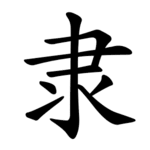Radical 171
Radical 171 or radical slave (隶部) meaning "slave" is one of the 9 Kangxi radicals (214 radicals in total) composed of 8 strokes.
| 隶 | ||
|---|---|---|
| ||
| 隶 (U+96B6) "slave" | ||
| Pronunciations | ||
| Pinyin: | lì | |
| Bopomofo: | ㄌㄧˋ | |
| Wade–Giles: | li4 | |
| Cantonese Yale: | dai6 | |
| Jyutping: | dai6 | |
| Japanese Kana: | タイ tai (on'yomi) およ-ぶ oyo-bu (kun'yomi) | |
| Sino-Korean: | 이 i, 대 dae, 례 rye, 예 ye | |
| Hán-Việt: | đãi, lệ | |
| Names | ||
| Japanese name(s): | 隷旁/れいづくり reizukuri | |
| Hangul: | 미칠 michil; 종 jong | |
| Stroke order animation | ||
 | ||
In the Kangxi Dictionary, there are 12 characters (out of 49,030) to be found under this radical.
隶 is also the 178th indexing component in the Table of Indexing Chinese Character Components predominantly adopted by Simplified Chinese dictionaries published in mainland China.
隶 is the original form of 逮. It is also used as the simplified form of 隸 in Simplified Chinese.
Evolution
 Small seal script character
Small seal script character
Literature
- Fazzioli, Edoardo (1987). Chinese calligraphy : from pictograph to ideogram : the history of 214 essential Chinese/Japanese characters. calligraphy by Rebecca Hon Ko. New York: Abbeville Press. ISBN 0-89659-774-1.
- Lunde, Ken (Jan 5, 2009). "Appendix J: Japanese Character Sets" (PDF). CJKV Information Processing: Chinese, Japanese, Korean & Vietnamese Computing (Second ed.). Sebastopol, Calif.: O'Reilly Media. ISBN 978-0-596-51447-1.
This article is issued from Wikipedia. The text is licensed under Creative Commons - Attribution - Sharealike. Additional terms may apply for the media files.